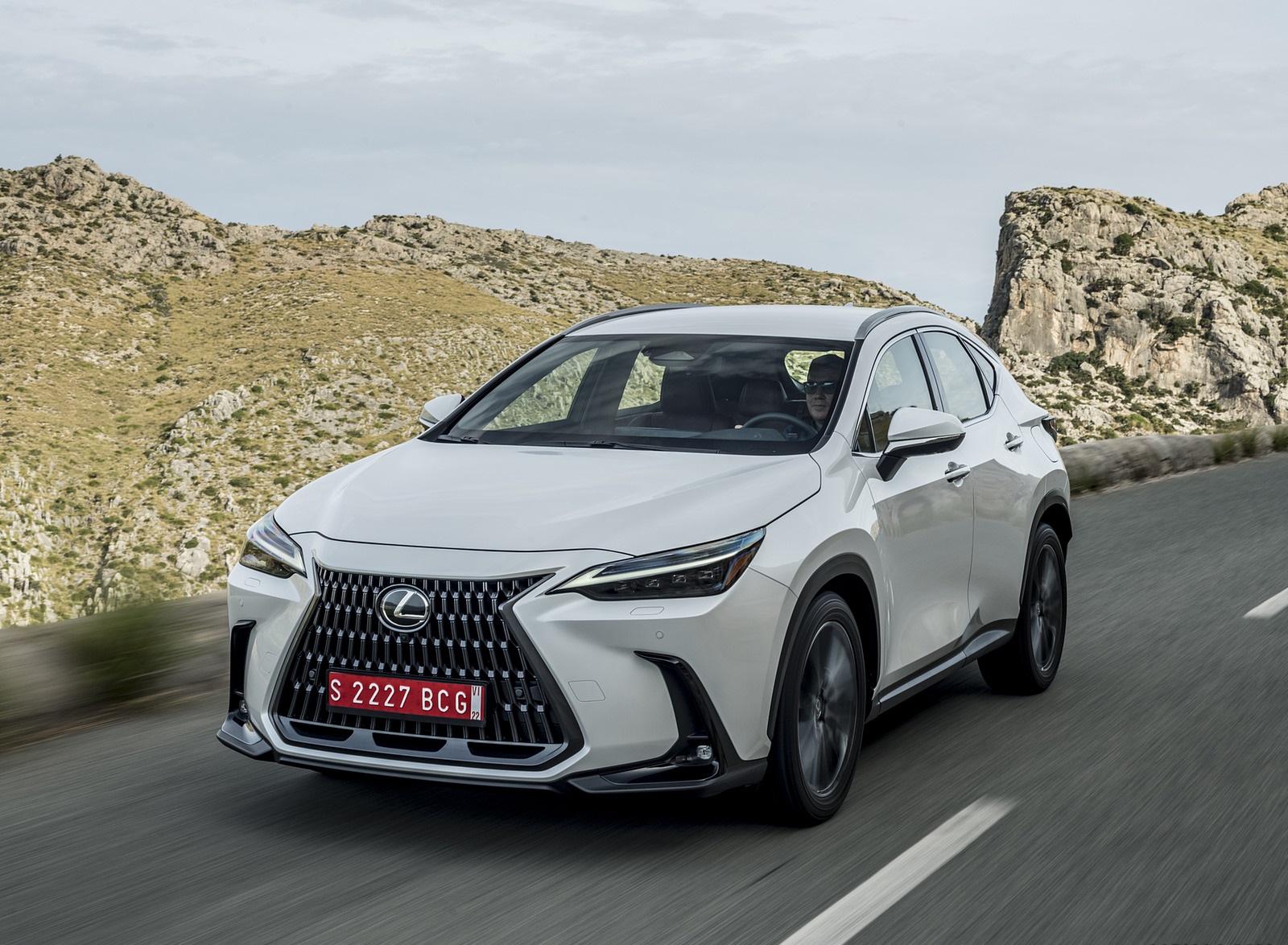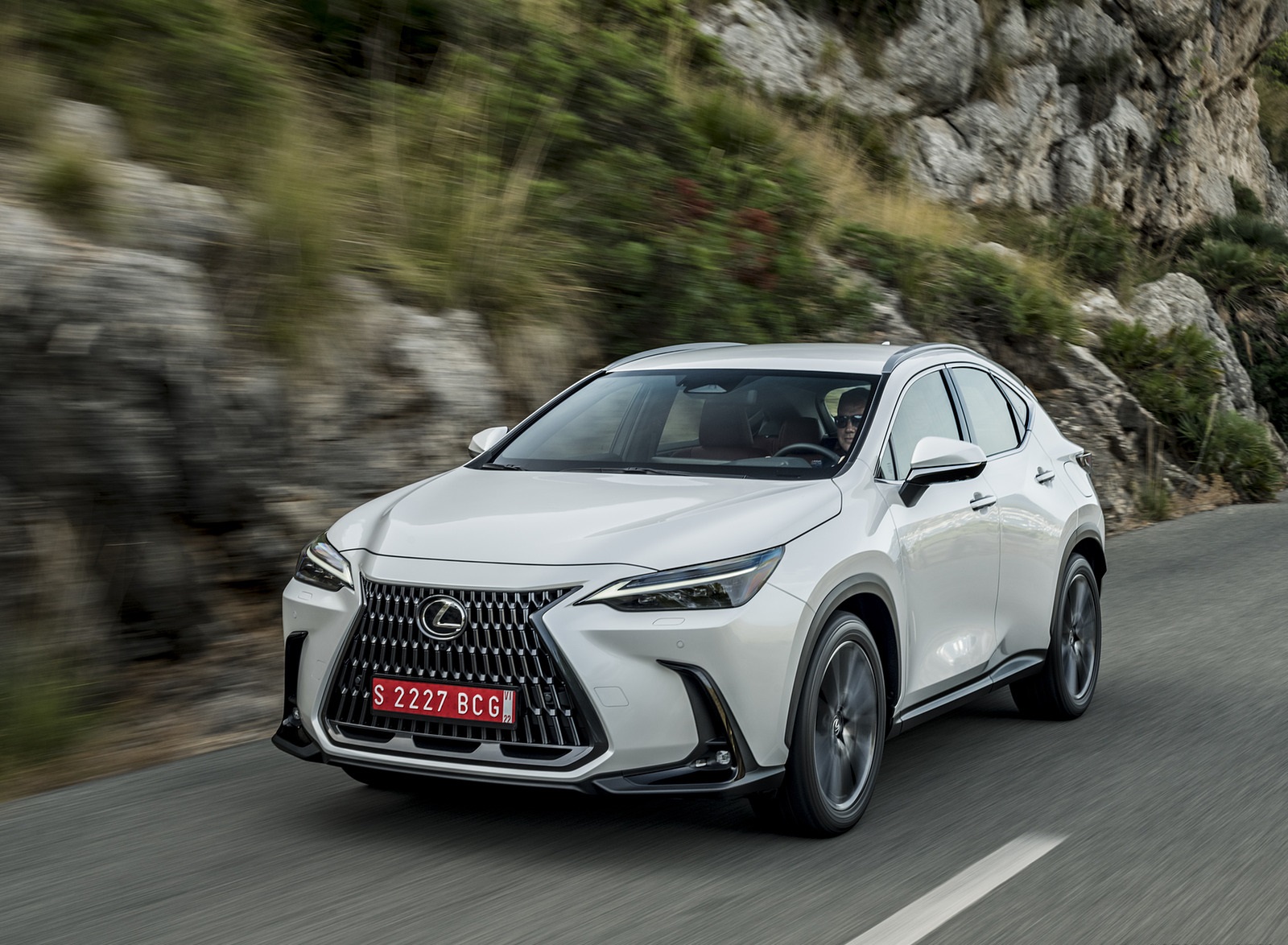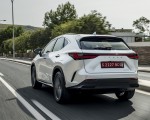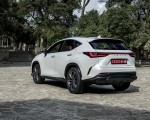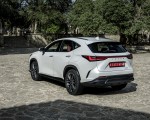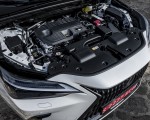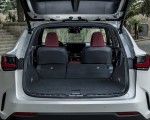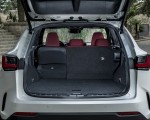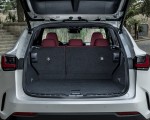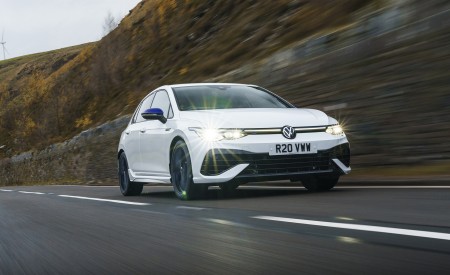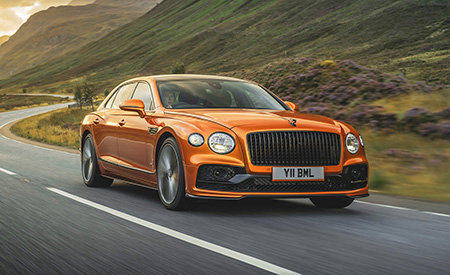2021 Lexus NX 250 (Euro-Spec)
- The new NX opens the next chapter for the Lexus brand.
- Second generation of the mid-size luxury SUV introduces new design, new powertrains, new connectivity, safety and convenience technologies and comprehensively improved dynamic performance.
- Introduction of Lexus’ first plug-in hybrid electric model, the NX 450h+.
- Significant performance and efficiency gains in the new NX 350h with fourth generation hybrid electric technology.
The all-new Lexus NX is much more than a second generation of Lexus’ mid-size luxury SUV, it opens the next chapter for the Lexus brand. It heralds new directions in design, new powertrains, including Lexus’ first plug-in hybrid electric, and a leap forward in dynamic performance that delivers a greater and more rewarding connection between driver and machine with the Lexus Driving Signature.
The NX also debuts a new multimedia platform that takes connectivity, information and convenience to a higher level, and benefits from expansion of the scope and functionality of the next generation Lexus Safety System + active safety and driver assistance systems to help guard against an even wider range of accident risks and reduce the burden on the driver.
Lexus is redefining the mid-size luxury SUV segment with a car that is comprehensively new – in fact no less than 95% of the vehicle’s parts are newly developed.
THE ALL-NEW NX: MARKET PROFILE
The new NX will play a defining role in shaping the future of the Lexus brand in Europe and driving the company’s growth ambitions.
The original NX, introduced in 2014, became Lexus’ best-selling model in the region, with more than 175,000 units sold, most of them to customers new to the brand. Currently, the NX accounts for around one third of Lexus’ European sales volume. NX is also a core model globally, with cumulative worldwide sales already above one million units.
The all-new model is equipped to do even better, with new and improved electrified powertrains with class-leading performance and efficiency, competitive new petrol engines for eastern markets and the introduction of wealth of new technologies to make every journey safer, more connected and more enjoyable.
Up to 10-year warranty
The new NX is sold with Lexus’ three-year/100,000 km manufacturer warranty, but with the new Lexus Relax programme, customers can extend this cover by a further year and 15,000 km each time they have their vehicle serviced at an official Lexus centre. The warranty is provided at no extra charge as part of the fixed-price service and extensions can continue until the car reaches its 10th anniversary, or 160,000 km driven.
FEEL MORE IN EVERY MOMENT: THE DEVELOPMENT CONCEPT
- “Vital x Tech” concept combines dynamic agility with the use of advanced technologies
- New NX represents the first step in Lexus’ brand transformation, benefiting from new approaches to product development, design and testing
- Feel More in Every Moment – the slogan expressing the sensory and driving appeal of the new NX
“Vital x Tech” was the over-arching concept theme for the new NX – Vital expressing dynamic agility and Tech representing innovation with advanced technologies.
Chief Engineer Takeaki Kato explains: “The new NX is designed to meet the diverse lifestyles of customers around the world with a complete renewal of its key strengths, including electrification, design, driving performance and advanced technologies to broaden its appeal.”
This approach has delivered important advances, including a new design language; Lexus’ first plug-in hybrid electric; a connected and rewarding driving experience with the Lexus Driving Signature; a focused and intuitive driver’s cockpit designed with the new Tazuna architecture concept; and the application of advanced, human-centred technologies for safety and convenience.
The NX programme has brought about a major change in Lexus’ approach to new vehicle development, applying digital modelling and computer techniques for smarter engineering that can achieve a higher level of quality assurance. At the same time, the takumi-led skills of the human hand, ear and eye remain essential to achieving the highest sensory quality.
There was also a focus on early adoption of new technologies for safety and comfort, while containing costs to ensure affordability for customers.
The elements in the development concept are brought together in the spirit of Feel More in Every Moment – Lexus’ expression of the rich sensory and driving appeal of the new NX.
FEEL MORE SOPHISTICATED: A NEW DIRECTION IN LEXUS DESIGN
- New design approach, maintaining the foundation of the Lexus L-finesse design philosophy
- The NX’s avant-garde quality is maintained, but with a more mature, sophisticated and muscular look
- “Functional beauty” blending design with performance to produce styling that delivers improved aerodynamics, noise reduction and fuel efficiency
Lexus design enters a new period of evolution with the launch of the new NX, while remaining true its core L-finesse philosophy – the application of leading-edge design and technology, with finesse.
The intention has been to preserve the avant-garde character that proved so attractive to customers with the first-generation model while using a more sophisticated, mature and dynamic design language. The result is “functional beauty,” a blending of design with performance to produce styling that delivers improved aerodynamics, noise reduction and fuel efficiency.
The bodywork presents contrasting curved surfaces and sharp angles, with dynamic proportions that express agility and a road-gripping look. Optimum packaging has been achieved with the use of Lexus Global Architecture K (GA-K) platform, providing more cabin space and a generous load compartment. Compared to the previous generation NX, overall length has increased by 20 mm, the wheelbase by 30 mm, the width by 20 mm and the height by 5 mm. The GA-K platform allows for wider front (+35 mm) and rear tracks (+55 mm), which adds emphasis to the car’s powerful stance, and also accommodates larger diameter wheels and tyres (18 to 20-inch rims and 720-740 mm diameter tyres).
At the front, the hallmark Lexus spindle grille plays a more integral role in the design. It has a more upright position, which helps improve airflow into the engine compartment, and dispenses with its chrome frame. Its lines flow back to accentuate the long bonnet and generate the overall form and volume of the body as it flares broadly through the muscular rear wings. The elegant shape of the bonnet also supports good forward visibility from the driver’s seat.
The grille has a new mesh pattern comprising U-shaped blocks that create a stronger three-dimensional look (the same U-motif can be seen in the design of the high-grade alloy wheel).
High-grade models are fitted with four-projector LED headlights, with Lexus’ first slim Adaptive High-beam System (AHS). Each of the units contains 11 LED chips with light output controlled by a forward camera. L-shaped daytime running lights are positioned above the headlights and have seamless surface illumination with a fade-out function when the driver uses the turn indicators. The standard headlights are bi-beam LED-type with Automatic High Beam (AHB).
The long and sleek front-end contrasts with a condensed rear section with short overhangs and powerful haunches. The rear view is distinguished by new L-shaped all-LED light clusters, and Lexus’ signature blade lighting in a bar that spans the width of the vehicle, a feature first seen on the UX compact luxury SUV. On the tailgate, the Lexus emblem has been replaced with the “LEXUS” name, creating a more modern and simpler look and strengthening the car’s identity.
The new NX is available in 11 colours, including three shades that use Lexus’ advanced sonic paint technology – Sonic White and new Sonic Grey. Five ultra-thin layers of paint with compressed pigments are applied and hand polished to achieve striking light and shade contrasts and a deeper lustre across the bodywork.
The NX F SPORT models feature dark chrome exterior details, a mesh grille and 20-inch alloy wheels with a 10-spoke design inspired the wheels used on Lexus’ LC flagship coupe. There are also new front and rear bumper designs with larger side vents cut into the front bumper. Two colours are exclusive to the F SPORT models – Sapphire Blue and F White.
FEEL MORE IN CONTROL: A NEW CONCEPT IN CABIN ARCHITECTURE
- First model to feature Lexus’ new Tazuna driver’s cockpit concept
- Layout of controls and information sources optimised for “hands on the wheel, eyes on the road” with minimum hand and eye movement needed for operation
- Design adds to the quality of the driving experience, inspiring confidence and raising the driver’s feeling of control and connection with their vehicle
The new NX is the first model to feature Lexus’ Tazuna concept for the driver’s cockpit, an approach that was first revealed in the Lexus LF-30 Electrified concept car.
Taking its name from a Japanese word describing a rider’s use of the reins to control a horse, it focuses on giving the driver direct, intuitive control of the vehicle, following the principal of “hands on the wheel, eyes on the road”. It also raises the quality of the driving experience, making the driver feel confident and in command of their vehicle and their surroundings.
Chief Engineer Takeaki Kato explains: “We have redefined the ideal cockpit space as the contact point between driver and vehicle, aiming for a cockpit that enables a deeper and more intuitive connection and allows for more faithful controllability of the vehicle.”
Information at-a-glance
To help keep the driver’s attention focused on the road ahead, the primary sources of information – the multi-information display, multimedia screen, gauges, meters and optional head-up display – are grouped so they can be read at-a-glance.
The head-up display can be used in three modes to show different levels of information: full mode includes the status of the Lexus Safety System+ safety and driver assistance features; standard mode summarises key information at the lower edge of the display; and minimum mode shows only the speed. It can be adjusted for position, rotation and brightness, with details saved on models with driver-personalised memory settings.
The meters on high grade models are High Definition and their appearance can be customised with a choice of three layouts; there is an exclusive meter design for the F SPORT models, featuring a tachometer, hybrid system display and speedometer. Touch tracer switches on the steering wheel can be used to change or update the contents of the multi-information display without having to look away from the road ahead.
The steering wheel has a new design that will be adopted on other new generation Lexus models. Takumi craftspeople helped precisely determine its cross-section shape and the position and shape of the thumb rests to give the best grip feel and enhance the driver’s feeling of control and connection with the car. The shift lever – styled like that found in the Lexus LC and LS flagship models – was made as compact as possible, but with a snug fit in the hand and set at an ideal angle.
Lexus measured the shoulder-to-fingertip distance of people around the world to ensure excellent control without disturbing the driver’s posture. Similarly, the length of the arm rest on the centre console has been increased by 84 mm, improving comfort for both the driver and front seat passenger. The cockpit feeling is created by the shape of the driver’s space curving around from the door to the centre console.
Simplified switchgear
The number of physical switches has been reduced from 78 to 45 in the new NX and they have been grouped in defined zones according to their function. Physical buttons have been retained for the most frequently used functions, for quicker, more intuitive operation. Those used when driving are arranged around the steering wheel; the audio and air conditioning controls have been consolidated in the central display screen; and driving controls that can be used when the vehicle is stationery are located in the centre console.
The ergonomic layout promotes smooth movement of the driver’s hands through start-up, shift operation and drive mode selection.
Touch tracer switches
An example of the intuitive control that’s central to the Tazuna concept is the touch tracer switches on the steering wheel. These can be customised to operate the driver’s preferred functions, such as air conditioning controls or the Panoramic View Monitor. When a switch is used, it is replicated in the head-up display, so the driver doesn’t have to look down at the wheel to confirm the function they want to operate. If the head-up display is switched off, the operation guide is shown in the multi-information display. Although they work by touch sensitivity, they have the “click” feel of physical controls. Their level of touch sensitivity can be adjusted to suit driver preference.
FEEL MORE LUXURIOUS: LIFE ON BOARD
- Passenger environment evokes the feeling of a luxurious lounge
- Takumi craftsmanship produces rich sensory appeal with fine-quality materials
- Lexus’ omotenashi hospitality witnessed in welcome lighting, ambient cabin lighting with 64 colours and e-latch electronic door release system
- Functions can be operated remotely using the Lexus Link app
While the driver experiences the focused, engaging environment created by the new Tazuna cockpit design, passengers enjoy a greater sense of space with an elevated level of comfort, quality and attention to detail that are quintessentially Lexus, evoking the feeling of a luxurious lounge. Applying the Vital x Tech concept has created a cabin that is innovative, elegant and practical.
The design delivers a “tangible space” – a concept whereby areas of open space are integrated in the design, rather than simply being a void between different solid elements. This helps create a luxurious lounge feeling for the front seat passenger.
The design, quality and finish exemplify the Lexus traditions of omotenashi hospitality and takumi artisan craftsmanship, using fine-quality materials and precision methods to ensure everything you see, touch and hear is perfect.
Seat design
Comfort is addressed in details such as the precise design of the front seats, with particular attention paid to the cross-section shape, the position of the side-supporting bolsters with concave cut-out areas so there is room for unobstructed elbow movement when reaching for controls or using the console box. The “deep hung” seat construction sets the upholstery seams deeper in the structure, helping the occupant maintain a better posture and with less upward pressure when cornering.
Eight-way power adjustment, plus lumbar support, is available for the front seats on high grade models, while on F SPORT models additional forward/back headrest adjustment is provided.
Performance of the integrated seat heating and ventilation has been improved with better temperature distribution across the seatback and cushion.
Welcome sequence
Lexus’ omotenashi hospitality is demonstrated by the welcome sequence as the driver approaches and enters the vehicle. The door handles, puddle lights and daytime running lights illuminate and as the door is opened, the instrument panel lights up. On closing the door, the NX side silhouette appears in the multi-information display and when the brake pedal is pressed, the power button pulsates. Switching the vehicle on initiates a start-up animation with graphics and sound.
Ambient lighting
Gentle, indirect cabin illumination can be adjusted using the Lexus Mood Selector to help create the right effect for every journey, with ambient lighting in the footwells, door panels and centre console. There are 64 different colours to choose from; of these, 14 have been pre-defined to reflect different moods inspired by nature.
Lexus’ first e-latch system
The NX is the first Lexus model to be fitted an e-latch electronic door release system. This replaces the familiar internal door handle with a push-button switch positioned next to the arm rest in the door panel; on the outside, a small button is located on the inside of the fixed handle.
This allows the door to be opened with a smooth, simple and near-silent motion, inspired by the traditional shoji sliding room dividers in Japanese homes. The e-latch incorporates a safety cancelling function, Safe Exit Assist, to prevent doors being opened in the path of vehicles approaching from the rear (details in the safety chapter below).
Climate Control system
The air conditioning system has been designed to deliver both more comfort and fuel-efficient performance. Both the hybrid electric NX 350h and plug-in hybrid electric NX 450h+ use a power-saving all-electric compressor.
The Climate Concierge ensures cabin temperature is precisely adjusted to suit each occupant, co-ordinating operation of the seat and steering wheel heaters as well as the air conditioning. With S-Flow control, the system recognises which seats are occupied, directing heating or cooling performance accordingly, while also taking into account the temperature setting, the cabin temperature, the ambient temperature and the effect of sunlight through the windows.
The system featured in the NX 450h+ uses an energy-saving heat pump which draws thermal energy from the air outside the car to heat the cabin, so there is less impact on the car’s EV driving capability. The plug-in electric also has a humidity sensor, to help prevent the windscreen misting over, two-layer air control and a system for detecting and suppressing stale air in the cabin.
Using the Lexus Link app, owners can activate the car’s heating and ventilation before setting out, for example cooling the cabin or de-icing the screen in preparation for a journey. In a planned future update to the app’s functions, NX 450h+ owners will be able to set the time for operation in advance.
Load compartment
The ”no compromise” packaging of the NX’s interior allows for a generous load capacity: the load space height is the same as in the previous model but is 40 mm longer. Thus, load space is 545 litres with the rear seats in place – more space for day-to-day use. This increases to a maximum 1,436 litres with the seats folded down. There is sufficient room to carry three golf bags or two large suitcases (77 and 63-litre), without the seats being lowered.
The deckboard divides three ways to allow for different arrangements of the boot space and is designed so that the storage area below can be reached without having to remove the entire board. The lower area can be used for storing tools and small items; notably on the NX 450h+ there is room for the charging cable, so that no space is lost in the principal load compartment area. The boot is also equipped with a side storage net and a lightweight folding tonneau cover that can be stored in a dedicated space in the boot floor. The rear seats are divided 60:40 for flexible load space and are available with a power-folding function.
Power back door
A new low-speed/high-torque spindle-type electric motor makes operation of the power tailgate quicker, with no delay between operating the control switch and the start of the door moving. Overall, opening and closing time has been reduced by half to around four seconds. The process is also quieter and with a more compact unit, there is less intrusion in the driver’s rearward view.
The back door can be opened and closed using a switch on the instrument panel or the button on the vehicle key; there is also a switch on the underside of the tailgate and an additional switch to close the door and lock the vehicle. The system is available with a kick sensor for hands-free opening. The opening height of the door can be set to a preferred height, for example to avoid hitting a low garage ceiling. An assist function will close the door fully when it is pulled down manually.
Upholstery and trims
According to model grade, seat upholstery is in high-quality L-fineskin fabric with synthetic leather in Black or Dark Rose, or full Tahara synthetic leather or genuine leather, both available in Black, Black with Rich Cream (with deep orange stitching), Dark Rose or Hazel (with matching Hazel headlining). The NX F SPORT models also feature leather, in Black, White or Flare Red, the latter two featuring contrasting black bolsters and inserts in the seatback and cushion.
The range of trim inlays includes Micro Dot, with a pattern expressing motion, and 3D Black Prism with a 3D carved look. Sumi Black Walnut has a strong wood grain finish while for the F SPORT the F Aluminium has a cool, sharp appearance.
Calm and quiet cabin environment
Lexus undertook noise risk mapping of the cabin during the initial development phase, to locate potential noise sources and suppress noise generation. This helped prevent noise caused by factors such as material compatibility and relative movement between components. Materials, surface treatments and the alignments of cross-sections were checked and the data gathered was evaluated.
To achieve class-leading cabin quietness, acoustic-quality glass is used for the windscreen and front side windows. Flush door mouldings and a new twin-latch system for securing the bonnet further contribute to reducing intrusive noise in the cabin, while the wheel arch liners reduce the noise from water splash. This is also the first Lexus to feature foam coating at the base of the front and centre pillars to reduce noise and vibration.
An example of the level of detail in noise suppression measures is the low noise register design of the fins in the fascia air vents: noise from the airflow is reduced by small protrusions on the surface of the fins, arranged in a serrated pattern.
The NX 350 is equipped with Active Noise Control (ANC), which reduces booming sounds generated by the engine and propshaft, and Engine Sound Enhancement (ESE), which transmits a pleasing engine note through an audio speaker in the cabin.
FEEL MORE RESPONSE – AND RESPONSIBLE: POWERTRAINS AND PERFORMANCE
- All-new electrified and petrol ICE powertrains with class-leading performance
- NX 450h+, Lexus’ first plug hybrid electric and halo model of the range, with 309 DIN hp, combined CO2 emissions between 20 and 26g/km* and 69 to 76 km EV combined driving range – even increasing to 89 to 98 km in the urban cycle
- NX 350h with fourth generation Lexus hybrid system, with 244 DIN hp corresponding to 24% increase in power, and 10% reduction in CO2 emissions vs previous system
- New four-cylinder petrol engines for Russia and Eastern European markets
- NX 350 with 279 DIN hp 2.4-litre turbo engine
- NX 250 with naturally aspirated 199 DIN hp 2.5-litre engine
- Both engines use Direct Shift eight-speed automatic transmission and feature full-time all-wheel drive
The new NX’s status as a transformative model for Lexus and its potential for greater market penetration is reflected in a wider range of powertrains, using new and significantly improved technologies to deliver best-in-class performance and wider market appeal. The line-up includes Lexus’ first plug-in hybrid electric, a model that instantly becomes a reference point for the segment in terms of its combination of power and greater zero emissions EV driving capability.
The range also offers a new hybrid electric model, with significantly enhanced performance and efficiency, and new petrol engines will strengthen the NX’s competitiveness and appeal in Russia and Eastern European markets.
NX 450H+, LEXUS’ FIRST PLUG-IN HYBRID ELECTRIC
Lexus has drawn on more than 15 years of hybrid technology expertise to produce its first plug-in hybrid electric vehicle (PHEV), the new NX 450h+.
The halo model in the new NX range, it features a four-cylinder, 2.5-litre hybrid Atkinson cycle engine, a 134 kW front electric motor, a 40 kW rear electric motor, hybrid transaxle and a lithium-ion battery with 18.1 kWh capacity – the highest capacity in its class. The engine’s high output and fuel efficiency are supported by a long, 103.4 mm stroke and high 14.0:1 compression ratio, together with Dual VVT-i electrically controlled intelligent variable valve-timing and D-4S direct/indirect fuel injection with multi-hole injectors.
The full plug-in system, including electric motors and battery, produces a maximum 309 DIN hp/227 kW, enabling acceleration from 0-100 km/h in 6.3 seconds. At the same time, CO2 emissions between 20 and 26g/km* and fuel economy between 0.9 and 1.1 l/100km* are class-leading.
Thanks to its powerful battery and superior efficiency, NX 450h also provides a substantially higher EV range. At 69 to 76km* in the combined WLTP cycle, or even 89 to 98km in the urban cycle, this is more than twice the range offered by competitors in the segment. The new battery’s performance also enables all-electric driving at speeds up to 135 km/h. Using Lexus’ new compact and lightweight hybrid transaxle, the plug-in hybrid electric system delivers best-in-class fuel efficiency and power.
The NX 450h+ is equipped as standard with Lexus’ intelligent E-Four electric all-wheel drive system (details in the dynamic performance chapter below) and has a 1.5-tonne (braked) towing capacity.
*Depending on grades and equipment. All data for combined WLTP cycle. Target data, pending homologation.
High efficiency maintained after battery depletion
The Lexus plug-in hybrid electric technology has the crucial benefit of maintaining high efficiency when the battery is depleted. In many competitor systems, operation at this point defaults to an internal combustion engine, but in the NX 450h+ the default is to an efficient, self-charging hybrid system. Lexus’ testing shows that its competitors’ fuel consumption is on average 30% higher when the battery is depleted.
Battery recharging can be accomplished in around 2.5 hours using a 230 V/32 A connection and the 6.6 kW on-board charger.
Lithium-ion battery
The addition of a boost converter to the hybrid system’s power control unit increases the voltage, allowing more power to be sourced from the battery, which has 96 cells and a voltage rating of 355 V.
Being more energy-dense, the battery unit is compact and can be accommodated in the vehicle’s platform without intruding into the cabin or load space. Its location also contributes to the car’s low centre of gravity. The load compartment has the same volume as the NX 350h hybrid electric model, with no space lost to powertrain components. Acknowledging how customers in the NX’s segment will typically use their vehicle for longer journeys, the fuel tank capacity is also unaltered, at 55 litres, one of the largest in the car’s class.
Hybrid system drive modes
The driver can select from four drive modes for the plug-in hybrid electric system.
EV (electric vehicle) mode is the default: the NX 450h+ will run purely on electric power until the limit of its range is reached, no matter how hard the accelerator is pressed. When the battery is depleted, operation switches automatically to efficient HV (hybrid vehicle) mode.
The Auto EV/HV mode automatically brings the hybrid engine into play when extra power is needed, then returning to EV operation immediately afterwards. The driver can also select HV mode to maximise efficient operation, automatically maintaining the battery’s state of charge.
Battery charging mode starts the engine to restore the battery charge level, helping ensure more battery power is available when EV driving is required, for example prior to entering a zero or low emissions zone.
Drive Mode Select
In addition, the driver can use Drive Mode Select to adjust the performance of vehicle systems to suit the journey, using a new-design control on the centre console. Normal mode gives a balance between driving performance and economy, while Eco mode adapts throttle response and air conditioning performance to support fuel economy. Sport mode adjusts steering feel and accelerator response for a sportier drive.
On F SPORT models equipped with Adaptive Variable Suspension (AVS), Sport mode is replaced by Sport S and Sport S+. Selecting Sport S+ provides additional control of the AVS and electric power steering (EPS) to give more focused sporting, responsive performance. An additional Custom mode allows the user to apply their preferred settings for the powertrain, AVS, EPS and air conditioning.
Sequential Shiftmatic transmission
The driver can use paddle controls to operate the Shiftmatic transmission in a series of shift ranges, selecting “S” with the shift lever. This delivers engine braking force in six steps with a shift feel similar to a manual transmission. A low shift range enables high engine speed control for sharp acceleration response, increasing driver rewards.
NX 350H WITH FOURTH GENERATION LEXUS HYBRID ELECTRIC TECHNOLOGY
The new NX 350h uses fourth generation Lexus hybrid electric technology, achieving much higher performance and greater efficiency.
The hybrid electric system, uses the same 2.5-litre Atkinson cycle engine as the NX 450h+ plug-in electric hybrid but with increased output thanks to a different ECU. It generates 24% more power than the previous NX 300h, with maximum output of 244 DIN hp/179 kW. This is reflected in a 16% reduction in the 0-100 km/h acceleration time to 7.7 seconds.
The new hybrid transaxle delivers the best combination of fuel economy and power in its class, an achievement supported by its redesigned geartrain, more compact design, lighter weight and reduced friction losses. It also has a smaller and more efficient power control unit.
The NX 350h is available with front-wheel drive or E-Four electric all-wheel drive. The towing capacity for the FWD model has been increased to 1,500 kg, matching the capability of the AWD version.
In common with the NX 450h+, the hybrid electric NX 350h features the Drive Mode Select and Shiftmatic system with paddle shift control. Its lithium-ion battery pack is located beneath the rear seats, positioned as low and close to the centre of the vehicle as possible to help maintain a low centre of gravity and optimum front/rear weight balance.
NEW PETROL ENGINES FOR THE RUSSIAN AND EASTERN EUROPEAN MARKETS
Lexus is introducing two new petrol engines in the NX range, available in Russia and Eastern European markets. Both are four-cylinder units – a 2.4-litre turbo and a naturally aspirated 2.5 litre.
The 2.4 turbo, featured in the new NX 350, has been engineered for high output and high torque, giving the driver a sense of flowing, uninterrupted power. Maximum power of 279 DIN hp/205 kW is produced at 6,000 rpm, with peak 430 Nm of torque delivered from 1,700 – 3,600 rpm.
Key features of the new engine include a longer stroke of 99.5 mm, giving a 1.14 stroke/bore ratio, and a high (11:1) compression ratio that enhances thermal efficiency. An enlarged included valve angle and high-efficiency ports promote high-speed combustion, contributing to higher power and environmental performance.
The engine uses Lexus’ first centre fuel injection, delivering high-pressure injection directly into the centre of the combustion chamber, giving improved combustion, more power and lower emissions. The D-4ST system also provides low-pressure port injection; dividing the injection in this way helps achieve optimum combustion, while performance is enhanced through integrated control of the fuel system and turbo boost pressure.
The turbocharger is a new, high-efficiency unit that achieves power performance, fuel economy and emissions compliance with quiet operation.
Other features of the 2.4 turbo engine include a water-cooled intercooler, Dual VVT-i intelligent variable valve-timing, lightweight pistons, a variable capacity oil pump and a light and rigid aluminium ladder frame. Lexus’ first electronically controlled, full-time all-wheel drive is featured as standard (details in the Dynamic Performance chapter below).
The 2.5-litre unit, a version of the engine featured in the new NX’s hybrid electric and plug-in hybrid electric systems, is tuned to produce 199 DIN hp/146 kW. In Russia specifically, this strengthens the model’s appeal from a taxation perspective in a key market segment. in the region. It too has all-wheel drive as standard – a Dynamic Torque Control system (details in the Dynamic Performance chapter below).
The unit achieves world-class thermal efficiency and specific output. Sharing some of the advanced technologies deployed in the 2.4 turbo engine, including lightweight pistons and a continuously variable oil pump, it also adopts specific systems to promote performance and fuel and emissions efficiency. These include VVT-iE electrically controlled intelligent variable valve-timing on the intake side; D-4S fuel injection with multi-hole injectors and straight intake ports.
A variable cooling system controls the route and flow of coolant according to the engine’s running conditions. This enables quicker engine warm-up, reduces friction loses, improves performance of the air conditioning and supports overall fuel efficiency.
Eight-speed Direct Shift automatic transmission
Both petrol engines are matched to a new eight-speed Direct Shift automatic transmission, replacing the six-speed transmission previously featured in the NX. Although it has more ratios, the unit is more compact, being 5 mm shorter overall.
With the 2.4 turbo engine it provides powerful response at low engine speeds, realising the performance benefit of the turbocharger. With the 2.5-litre unit it helps achieve fuel efficiency comparable to a hybrid electric, while giving a lively driving experience. Its performance is helped by a new torque converter with a multi-plate lock-up clutch, giving precise lock-up control.
The transmission has a lower first gear ratio to enable smooth and powerful pulling away at start-up. A higher ratio is used for eighth gear to maintain low engine rpm in high-speed cruising, giving quieter performance with fuel economy.
FEEL MORE CONFIDENT: DYNAMIC PERFORMANCE AND THE LEXUS DRIVING SIGNATURE
- Lexus Driving Signature combines ride comfort with steering, throttle and braking response perfectly faithful to the driver’s intentions
- New NX built on Lexus’ GA-K platform, gaining fundamental benefits in dynamic performance
- High body rigidity support by use of advanced materials for construction and reinforcement
- Dynamic performance honed by professional racing drivers in the NX testing programme
Development of the new NX’s dynamic performance focused on delivering the Lexus Driving Signature, an ideal combination of ride comfort and steering, throttle and braking performance that is faithful to the driver’s intentions at every moment, inspiring confidence and a rewarding sense of control and connection with the car.
Central to achieving this is the use of Lexus’ Global Architecture K (GA-K) platform. Dynamically superior to the previous generation NX, this secures a lower centre of gravity (-20 mm), an increase in the front and rear tracks and an improved front/rear weight balance. It also provides the high level of rigidity required for dynamic, responsive and stable performance – 30% greater than the previous NX – supported by new braking, steering and suspension systems.
The aim was to achieve seamless cornering performance, from deceleration towards the turn, steering into the corner and accelerating out., together with more linear and powerful acceleration and an increased sense of engagement, agility and control for the driver.
One of the innovations in the development programme was the use of professional racing drivers to help hone the car’s dynamic performance and guarantee the Lexus driving “feel” – particularly steering and braking responsiveness – in track testing at Lexus’ new Shimoyama vehicle development facility.
Highly rigid body
The new platform has supported the engineering of a significantly more rigid body. Innovative lightweight materials are used to add strength and compensate for the weight of extra bracing and reinforcements. The structure includes world-first use of 1180 MPa steel for tailor-welded blanks in the rocker reinforcement and 1470 MPa steel for the roof reinforcement.
New laser peening technology has been adopted, using pulsed laser beams to improve weld penetration, allowing thicker, stronger materials to be used, notably in the roof rails and sills. Further rigidity is gained from laser screw welding and more extensive use of body adhesive (an additional 6 m), together with Lexus’ first application of high-rigidity foam, used in the rear corners of the hatch, to suppress deformation.
A new twin-latch system has been designed for securing the bonnet. A transverse reinforcement between the two locks adds to the rigidity of both the bonnet and the car’s body, and also suppresses vibration caused by air turbulence at higher speeds.
F SPORT models further benefit from front and rear, transverse-mounted performance dampers to absorb body vibrations and improve the car’s handling stability.
New suspension design
The NX uses a new front MacPherson strut suspension system, with double wishbones with trailing arms featured at the rear.
Throughout, the layout of the arms, bushes and shock absorbers has been refined to reduce shock and vibration when driving over rough surfaces. Measures include optimisation of the angle between the lower arms and upper supports; placement of the shock absorbers for a smooth stroke; and optimisation of the damping force control in the Adaptive Variable Suspension (AVS). Precise alignment of the strut bearing which connects the damper to the car helps produce natural steering response and straight-line stability. The shock absorbers themselves have redesigned bushes and seals and use a new fluid for improved performance.
Anti-roll bars are fitted front and rear, with a thin-wall, hollow construction that saves weight without detracting from performance. The rear bar on all-wheel drive models is shaped differently to accommodate the rear differential.
Axle rigidity is increased with the use of hub bolts in place of nuts to fasten the wheels, which also reduces the vehicle’s unspring weight; further weight gains are made with the adoption of a new aluminium axle carrier.
Adaptive Variable Suspension
The Adaptive Variable Suspension (AVS) featured on the NX F SPORT models has an expanded operating range and adopts a linear solenoid for the actuator, giving finer damping adjustment and smoother response to changes in the road surface and driving conditions. The result is less roll, sharper handling, greater ride comfort and a reassuring feel for the driver.
There are two types of damping force control in the AVS – Normal and Sport – operating according to the drive mode selected.
Braking system
A new braking system has been designed for smooth feel and pedal operation. Hybrid models use an electronically controlled system while petrol versions of the NX use a hydraulic brake system.
The ventilated front discs have a 328 mm diameter (340 mm on NX 450h+) and use floating double-piston callipers; at the rear there are 317 mm ventilated discs. Additional brake control systems have been introduced – Trail Mode for all-wheel drive models; Downhill Assist Control (DAC) for petrol all-wheel drive version) and Secondary Collision Brake (SCB).
For the driver there’s easier and more reassuring operation and feel with changes to the size and shape of the brake pedal and – for the first time on a Lexus model – a damping mechanism for the pedal return.
Steering
The electric power steering has a precise, rack-mounted motor, engineered to provide dynamic performance with a safe, confident and relaxed steering feel, making the car easy to drive and helping make longer journeys less tiring. Steering response is 20% faster than on the previous NX.
The hybrid electric and petrol NX versions have variable gearing which uses a low stroke ratio at steering angles up to 20 degrees, giving stability at high speeds; above 20 degrees the ratio is increased, giving better cornering agility.
Aerodynamics
Lexus designers and performance engineers collaborated closely to produce aerodynamic details that optimise stable performance without compromising the fundamental quality of the vehicle design, achieving a drag coefficient for the car of 0.34. This co-operation resulted in “functional beauty” – elements that control airflow around and over the vehicle, reducing drag while contributing to the car’s overall appearance.
Details include a flush belt moulding, profiling of the sides of the front bumper, openings in the corners of the rear bumper (these are larger on F SPORT models to support sportier performance) and a fin added to the lower part of the rear bumper. These help produce improved steering feedback, natural vehicle movement in response to steering inputs, straight-line stability and, for the driver, a strong sense of the vehicle gripping the road.
Beneath the vehicle, the engine under cover has a new dimpled surface, like a golf ball. This pattern generates micro-vortices that enhance the ground contact feel. The under cover area has been increased on all NX versions (hybrid electric, plug-in hybrid electric and petrol) to reduce drag, improving stability and fuel economy.
All-wheel drive systems
All-wheel drive is available across the new NX range at launch.
The lightweight and compact Lexus E-Four intelligent electric system is fitted as standard to the NX 450h+ plug-in hybrid electric model and is available as an option for the NX 350h hybrid electric. Using an additional electric motor on the rear axle, it provides automatic distribution of drive torque front/rear between 60:40 to 20:80, giving reassuring grip when pulling away or driving on snowy or slippery road surfaces.
Using the Trail Mode control – offered for the first time on a Lexus model – integrates control of the AWD system, braking and drive force to help prevent wheelspin when travelling on rough or loose surfaces, enhancing off-road driving performance. For example, if one wheel loses contact with the ground, Trail Mode will brake the spinning wheel and direct drive torque to the grounded wheel to gain traction, at the same time adjusting throttle response and shift pattern.
The NX 350 with the new 2.4-litre turbo engine uses Lexus’ first electrically controlled full-time all-wheel drive system. The system automatically optimises the front/rear torque distribution so that the vehicle delivers a confident feel and the best performance in any given driving situation. It analyses driver inputs and sensor data to adjust an electronically controlled coupling in the rear differential to achieve the ideal allocation of drive torque between the front and rear axles, from 75:25 to 50:50. The result is exhilarating yet refined performance with a strong feeling of the car behaving faithfully to the driver’s intentions with security and controllability.
The same benefits of grip and stability are delivered by the Dynamic Torque Control system used by the NX 250 with the 2.5-litre engine, with front/rear drive torque distribution automatically adjusted between 100:0 and 50:50, according to driving conditions. Pre-torque loading is constantly applied, contributing to stable acceleration. Both the NX 350 and NX 250’s systems receive information from sensors around the vehicle, measuring G-force, steering angle and wheel speed, with additional information on snowy road conditions obtained from the vehicle’s camera.
FEEL MORE CONNECTED: MULTIMEDIA AND CONNECTIVITY
- All-new multimedia platform with faster, more intuitive operation and increased functionality
- Lexus Link Connect with 9.8-inch touchscreen and Lexus Link Pro with 14-inch High Definition touchscreen – one of the largest in the NX’s class
- Up-to-the-moment route information with cloud navigation as standard
- Voice recognition system responds to conversational commands, including new “Hey Lexus” assistant
- Convenient over-the-air provision of system updates and new functions
- 4-year connectivity subscription offered as standard on all vehicles in Western and Central European markets.
- Bespoke 17-speaker Mark Levinson Premium Surround System available on high grade models
The new NX delivers seamless connectivity that is faster, better and stronger, providing the latest multimedia technology, “always connected” services and the convenience of over-the-air software and functionality updates.
Using smartphone, navigation, vehicle commands, multimedia functions and cloud connectivity, there are about one hundred ways for the driver to interact with the vehicle.
All-new multimedia platform
The new model marks the debut of an all-new multimedia platform that transforms performance with increased computing power, quicker response and more intuitive operation. Using the new touchscreen is as smooth and simple as using a tablet.
The standard system, Lexus Link Connect, features a 9.8-inch screen with an anti-glare finish. The CPU (central processing unit) has 2.4 times the computing speed of Lexus’ previous multimedia system. In addition to touchscreen operation, there are physical buttons to short-cut to the most frequently used functions. Menus and controls are displayed as icons on the driver’s side of the screen for easy access and the screen’s layout is divided into sections according to the level of information detail.
Lexus Link Pro, available on higher grade models or as an option, features a 14-inch screen, one of the largest in the NX’s class. Graphics are presented in High Definition for excellent visibility in all lighting conditions, while the CPU delivers even faster response – 3.6 times that of the current system; 1.5 times quicker than the “Connect” system. Colours and fonts can be changed with five different themes available.
Both systems can be customised for up to three different users; the system will automatically recognise when a specific device or key is used.
Cloud navigation
The new NX is the first car in its class to provide cloud navigation as standard (in markets where the service is available). The car’s DCM (data communication module) enables the navigation to be always connected, providing live information on traffic events, accidents and road conditions. Up-to-the moment information makes for more efficient journey planning and the avoidance of delays,
Voice recognition and the “Hey Lexus” assistant
The new multimedia system has improved voice recognition that responds to questions and commands given in a more natural style of language – Dynamic Voice Recognition. It can be used at the same time as the audio system and by both the driver and front seat passenger. It will recognise which seat the command has come from and respond accordingly, for example, opening the nearest window.
The user can speak in a conversational style, interrupting or changing their mind, and the system will understand. It will also understand context: for example, if you say “I’m hungry,” it will give details of nearby restaurants.
Voice recognition can be operated simply by calling up the new on-board assistant “Hey Lexus,” or by using switches on the steering wheel and multimedia display. “Hey Lexus” can interact directly with the vehicle, for example closing windows and adjusting the climate control. At launch, the voice recognition function will cover 19 different languages.
Smartphone connectivity
Easy smartphone integration is provided as standard – wireless for Apple CarPlay and with a wired connection for Android Auto. A wireless charging tray is available, with 50% quicker charging performance; this can also be slid forwards to access a handy small storage space, even when the unit is being used.
Convenience for everyone on board is addressed with four USB ports in the cabin, two on the front and two on the rear of the centre console. Of these, three are 15 W USB-C standard and can be used for device charging; the second port on the front of the console is USB-A, suitable for connecting a multimedia device. Accessory power sockets are provided on the centre console and in the load compartment.
Lexus Link
The DCM allows for an extended range of functions the owner can operate remotely using the Lexus Link app on their smartphone.
The connected services include locking and unlocking the vehicle, opening the tailgate, operating the steering wheel and seat heaters and adjusting the climate control to heat or cool the vehicle ahead of setting out on a journey. The car’s hazard lights can also be illuminated, for example to help spot the car in a busy car park.
These are in addition to established Lexus Link services such as driving analytics, hybrid coaching, fuel level monitoring and a “find my car” function.
Additional functions are available for the NX 450h+: monitoring the level of battery charge, scheduling charging and a charging timer.
The new DCM also allows for convenient over-the-air updates to adjust, improve and add services during the car’s lifecycle.
Premium sound system
The NX’s standard audio package is a 10-speaker system giving crisp sound throughout the cabin. A subwoofer uses the bass reflex structure of the rear speakers to give excellent low-frequency reproduction, and the system allows playback of high-resolution sound sources (96 kHz/24-bit). In some markets, an eight-speaker audio system is provided.
Mark Levinson Premium Surround Sound System
High grade versions of the hybrid electric and petrol NX can be specified with a new 17-speaker Mark Levinson Premium Surround Sound audio system.
Developed by Lexus’ exclusive audio partners, the system is optimised for the car’s interior architecture to deliver the finest sound reproduction quality. The NX is the first Lexus to use the Harman System for the playback of high-resolution sources.
The array of speakers, including a large-capacity 25 cm subwoofer in a bespoke chamber beneath the deck board, is arranged to give the effect of a 360-degree stage setting. Pure Play technology gives distortion free performance and high-resolution sound source playback is also supported. Quantum Logic Surround (QLS) improves the clarity and sound stage, while ClariFi 2.0 technology recreates sound quality lost in lower quality compressed files.
Control sounds
Some of the most frequently used controls and functions trigger a musical sound to confirm operation, such as the seatbelt reminder, clearance sonars and multimedia system. Lexus worked with jazz musician Jiro Yoshida to define the sounds produced.
FEEL MORE REASSURED: ADVANCED SAFETY AND DRIVER ASSISTANCE
- Third generation Lexus Safety System+ provided as standard, across all European markets
- Significant increases in the scope and functionality of active safety and driver assistance systems
- Enhanced Pre-Collision System can detect significantly more accident risk scenarios
- Optional Extended Safety Package with Lane Change Assist and Front Cross-Traffic Alert
- Industry-first Safe Exist Assist, combining the new e-latch system with the car’s Blind Spot Monitor, helps avoid accidents caused by opening doors into the path of approaching vehicles, bicycles and motorcycles
- Digital rear-view mirror, giving the driver a wide, unobstructed field of vision, using real-time images from the car’s reversing camera
- Panoramic View Monitor with underfloor see-through view
- Advanced Park system with Remote Parking
The new NX is the first model to feature the third generation of Lexus Safety System+, equipping it with a comprehensive package of active safety and driver assistance features.
Lexus’ safety leadership goes hand in hand with its commitment to making advanced accident risk detection and prevention measures accessible to more motorists. With this aim in view, Lexus Safety System+ is provided as standard on all new NX models, across all European markets.
The latest developments introduce new features and upgrades in the performance and functionality of others, with enhancement of the detection range of the millimetre-wave radar and camera. Systems have also been tuned to operate in a way that feels natural to the driver and thus more reassuring, adding to the driving confidence inspired by the NX’s new platform and powertrains.
With this evolution, Lexus Safety System+ moves to the next level as a personal driving partner.
Upgraded Pre-Collision System with Emergency Steering Assist
The Pre-Collision System’s (PCS) capabilities have been extended so that it can now detect motorcycles and pedestrians in the car’s path. It also gains a new function that identifies high collision risks with oncoming traffic or crossing pedestrians and cyclists when making a turn at an intersection from the opposite direction.
The new Emergency Steering Assist function provides assistance, triggered by the driver’s use of the wheel, to automatically control steering when there’s a high risk of a collision, helping to keep the vehicle stable and within its traffic lane. A new acceleration suppression function helps prevent unintended sharp acceleration when travelling at low speed.
The improvements that have been made enable the PCS to detect significantly more accident risk scenarios than before.
Adaptive Cruise Control
Performance of the Adaptive Cruise Control (ACC) has been improved so that it can more quickly recognise and adjust to traffic cutting in in front the NX. Working in conjunction with the Lane Trace Assist, it will follow a more natural line through bends and decelerate earlier in accordance with the sharpness of the curve. This speed control function has been developed to give performance more in line with the driver’s natural instincts.
A new indicator-linked pre-acceleration function automatically accelerates the car up to its target speed to shorten the distance to the vehicle ahead, in preparation for changing lane to overtake. Similarly, the system will slow the NX when the indicator is used to move into a lane behind a slower vehicle, giving a more natural feel to the driving assistance. Lexus’s first overtake prevent function which will automatically reduce cruising speed to avoid undertaking vehicles in the adjacent lane.
The system’s co-operation with the Road Sign Assist (RSA) has been expanded to respond to more signs and commands, including warning and STOP signs. When the RSA recognises a change in the speed limit, the system alerts the driver to adjust the car’s cruising speed accordingly.
Lane Departure Alert and Lane Trace Assist
Refinement of the Lane Departure (LDA) has focused on co-operation with driver, for example deactivating warning and restraint functions when it’s judged that the driver is making a deliberate manoeuvre to avoid a person or parked vehicle. The system can now recognise some solid objects, such as kerbs, guard rails, walls and utility poles, giving more natural lane tracing performance.
The Lane Trace Assist has enhanced recognition performance, giving smoother and less abrupt steering support. For example, when overtaking a vehicle in an adjacent lane, or when driving close to a roadside structure, the tracing position is offset from the centre of the road to the avoidance side, again following a driver’s natural instinct.
Extended Safety Package option
Owners can increase the NX’s safety provisions with an optional Extended Safety Package, available for higher grade models.
It introduces Lane Change Assistance (LCA) which provides automatic lane change steering, when the turn indicators are used in highway driving.
It also adds Front Cross-Traffic Alert which uses radar monitoring to detect and warn the driver of traffic approaching from either side when emerging from a junction at low speed. An animation of the direction of the approaching vehicle is shown in the colour head-up display and if the system judges the driver is about to pull out, it will prompt them to slow down with a warning display and buzzer.
Safe Exit Assist
The NX’s new e-latch electronic entry and exit system is linked to the car’s Blind Spot Monitor to warn of any traffic approaching from the rear. If it detects a risk, it triggers a warning light and buzzer and, if an attempt is made to open the door, cancel the unlatching.
Lexus believes this innovative system can help prevent 95% of the accidents caused by door opening.
Digital rear-view mirror
The NX can be specified with a Digital Rear-view Mirror which gives the driver a wide, unobstructed field of vision, using real-time images from the car’s reversing camera. The view is not compromised by headrests, passengers or luggage inside the car, and excellent clarity is maintained in night driving or poor weather conditions.
The mirror also has a conventional optical setting, for example if the rear camera becomes obscured by mud or snow. Touch controls are integrated in the glass for adjusting the angle of rearward view left/right and up/down. Image brightness and scaling can also be adjusted to suit the driver’s preference, or the driving conditions.
Panoramic View Monitor with underfloor see-through view
The Panoramic View Monitor available for the new NX features a new see-through view which displays an image on the multimedia screen showing the area beneath the car, as though the seats and bodywork were transparent. This gives the driver extra information about the vehicle’s immediate surroundings for even safer manoeuvring.
The see-through view can be shown when the shift level is in P; the driver can switch between this and the Panoramic View Monitor’s moving view using the display mode switching button. The underfloor see-through view is crated using previously taken camera images, so is not a real-time image.
The Panoramic View Monitor also provides Side Clearance View, a composite image using images from cameras in the door mirrors and on the front of the vehicle. This helps the driver judge clearances when passing another vehicle on a narrow road, or parking close to the roadside. The monitor can be operated when the vehicle is stationary, or at low speeds, up to about 20 km/h.
Advanced Park system with Remote Parking
The new NX is available with an Advanced Park system, like that featured on the Lexus LS flagship sedan. It provides all that’s required to make a parking manoeuvre, with automated control of the steering shift operation and braking.
The system uses the car’s array of four panoramic view monitor cameras and 12 ultrasonic sensors to gain an all-round appraisal of the car’s surroundings and parking space. It can be used for series and parallel parking spaces and has a memory function so that it will recognise up to three regularly used unmarked parking spots, for example at home or workplace. Operation is smooth, with fewer repositioning movements.
The Advanced Park system will be enhanced in the course of 2022 with a Remote Parking function, a Lexus first. The driver will be able to park his car in or out a tight parking spot from outside the car using his/her smartphone with the Lexus Link App. All NX already on the road at the time of introduction will also benefit from this new function via an over-the-air software update.
(Lexus Press Release)
View the complete gallery
Share your Thoughts!
